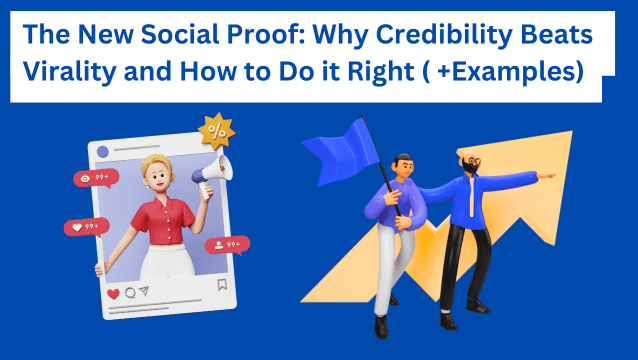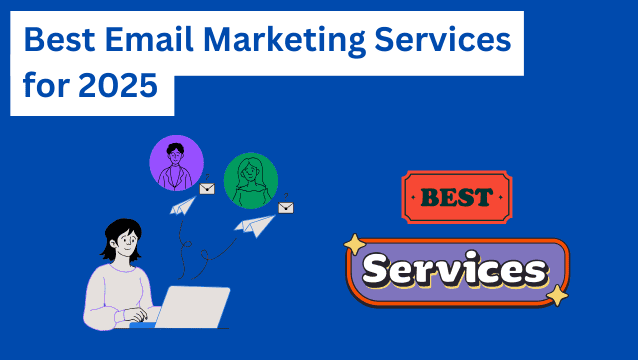Link juice is simple in theory. One page links to another, and some value flows with it. In practice, that value behaves like link equity. It helps search engines discover, understand, and rank pages in search results.
In this guide, we explain everything you need to know about link juice today. We cover the signals that shape it, its mechanics, safe link building, and how to route it with an SEO strategy that works.
Highlights
- Link juice still matters, but context, authority, and internal links decide who wins.
- Anchor text and on‑page context beat raw link totals most days.
- Fix broken links and redirect chains to stop equity leaks fast.
- Track your gains in Google Search Console and Google Analytics.
What link juice means in 2025
A link is a pathway. It helps search engines discover new URLs, crawl pages, and infer relevance.
Link equity, often called link juice, is the signal that travels along that path. It’s the accumulated weight from backlinks, content, and internal context.
A high‑fit mention from an authority domain can move a page higher in the SERPs. A random sitewide footer link usually won’t. More links do not guarantee higher search engine rankings. The value depends on relevance, placement, and the page that gives it.
Building link equity with relevant, authentic links is a fundamental part of search engine optimization. It shapes content and site structure so crawlers understand it, users enjoy it, and rankings reflect both.
Links as discovery and relevance signals
Links let bots and potential customers find your pages. They also add context with anchor text and nearby copy.
Internal links tell crawlers which pages are relevant in context to this page. External links can also help when they point to authoritative sources and clarify a claim or add value.
With so much increasing competition, your goal in 2025 is to earn relevant editorial endorsements and route internal link juice to the pages that convert.
The mechanics of link equity today
Here are the core signals that describe how equity works.
Anchor text and on‑page context
Anchor text helps search engines grasp the topic of the target page.
Descriptive anchors paired with relevant surrounding copy send a clear signal that the linked page is relevant. A link inside the main body carries more context than a boilerplate link. If readers click and stay, that engagement is proof that the content fits the query.

Internal links and website structure
Internal links route link juice. A pillar page can pass value to clusters, and clusters can point back to the pillar.
On the other hand, pages without internal links are orphan pages. They collect no internal equity, are harder to discover, and may have higher reader bounce rates.
Tight internal linking makes the user flow predictable, which creates a clean website structure. These related links, combined with breadcrumbs and thoughtful navigation, help crawlers find the pages that matter.

Link attributes (nofollow, sponsored, ugc)
Link attributes qualify endorsements.
The rel=”nofollow” attribute tells crawlers not to treat a link as a vote of confidence. The rel=”sponsored” attribute identifies paid relationships. The rel=”ugc” attribute marks community content.
These signals reduce the risk of mixing editorial links with paid or user‑generated ones. They also help you keep your outbound links clean and transparent.
Google’s documentation notes that links without an href attribute may not be parsed. In this case, these do not contribute to link juice.

Redirects, 404s, and chains
Broken links and 404 error pages waste discovery opportunities, while redirect chains slow crawlers and can dilute signals.
A short, direct 301 from an old URL to the best replacement is the safest path. Avoid long daisy chains and keep your XML sitemap updated when you consolidate.
Google’s redirection guide explains how to set these up with PHP and Apache. If you use WordPress, you can easily set these up with a tool like Rank Math and without touching code.

What actually affects how much link juice you get
Let’s look at the big levers that affect equity.
Referring domains’ quality and topical fit
A handful of high‑fit referring domains often beats a pile of random links. Context is the multiplier.
An editorial link from an authority domain in your niche can outperform low‑fit mentions. You can use third-party tools to check metrics like domain authority or authority score.
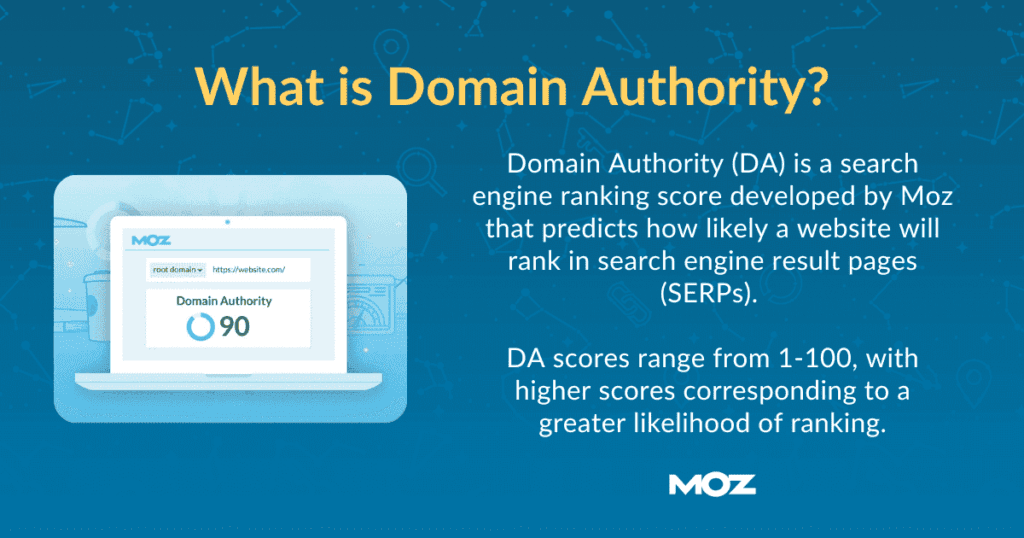
Placement and context
In‑content placements tend to carry more weight than footer or sidebar links. Anchor text that matches the topic and sits inside relevant copy sends a sharper signal.
However, the linking page needs to make sense on its own, not just exist to pass link equity. It should add value to the reader, ideally with unique content or perspectives.
Technical hygiene
Crawlable nav, tidy URL structures, and consistent canonicals help bots allocate budget. This should be part of your technical SEO black book.
Avoid duplicate sets from parameters and poor navigation. Watch out for hreflang mistakes. The hreflang tag should map one‑to‑one between alternates. That prevents equity from splitting across different page versions.
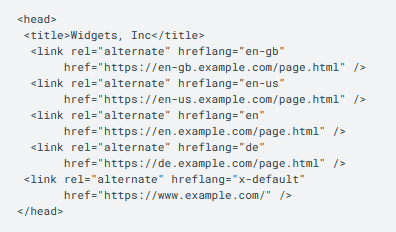
Global elements that leak equity
Here are some of the bad practices that can harm your link equity:
- Long redirect chains
- Noisy query parameters
- Duplicate pages that scatter signals
Patch these first to raise the ceiling on every link building effort. Then list them as checks in your SEO checklist that editors should follow before publishing.
If you use WordPress (WP), keep your .htaccess file tidy and monitor PHP warnings. Follow WP coding standards so templates don’t spawn thin duplicates. This is true across WP 6.0 through WP 6.8.
How to build link juice ethically in 2025
Here’s a playbook you can use to build authentic, long-lasting link juice in 2025.
Linkable assets and evergreen linkable content
Link baiting is creating valuable linkable assets that make other sites want to cite you. Think original data, calculators, and practical frameworks.
Evergreen linkable content keeps earning mentions over time. Practice content creation that solves real problems and attracts editorial links. Pair SEO with UX design and sales copywriting so those new visitors convert to qualified leads and buyers.
In fact, you can easily turn pieces of your posts into images and stories. Publish them on social media and link back to your site. If they’re valuable enough and you have a good following, you’re creating link bait.
Here’s an example from one of our articles that can be converted into an asset driver:
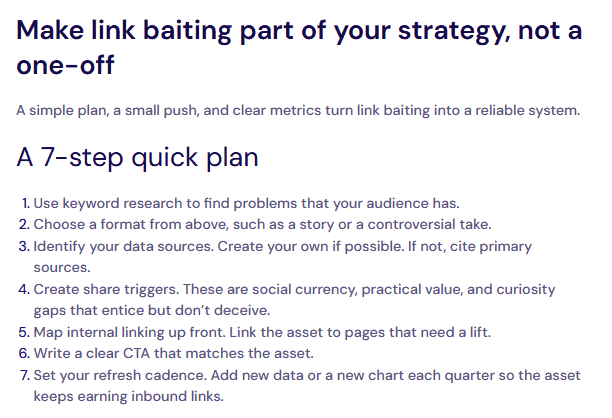
Digital PR and editorial links
Digital PR turns your insights into stories. Stories capture and keep human attention, making them a core part of any strong SEO strategy.
For example, pitch timely hooks to reporters from authority domains. Use quotes from content authors and subject matter experts. A credible comment on a trend can land a front‑page mention. That single link can push key pages and boost organic traffic.
Guest articles and brand partnerships
Guest blogging still works when the content is high quality and the partner is relevant. This is why most brands hire blogger outreach services if they don’t have the capacity to do this in-house. Brand partnerships also create co‑branded assets.
Brand partnerships include anything from building relationships with businesses in side niches to microinfluencers. For example, a lead generation SaaS could partner with an SEO agency for link juice and referrals.
Be clear about disclosures and keep user value front and center. Avoid paid links masked as editorial content. If you sponsor something, use rel=”sponsored”.
Link insertions with guardrails
Link insertions are fine when they actually improve the piece. Pitch gaps you can fill, not random mentions. Show the editor how your resource lifts clarity and adds context to the piece. If it feels forced, skip it.
For example, target posts from authority sites that can benefit from just one more paragraph or case study.
You can also consider using link building tools to gain free, high-quality backlinks. Some of these can scan authority sites and find relevant and matching pages that could earn a link insertion.
Quality link insertions keep your digital footprint clean and become a win-win for you and the editor.
Broken links and link reclamation
Use backlink analysis to find lost links and 404s, then reclaim these pages. Also search for unlinked brand mentions and ask for a link back to your site or a relevant page.
That is link reclamation. It’s one of the most basic examples of link building strategies. Yet, it’s fast, practical, and builds on goodwill.
Internal link juice you control
Earning links is hard. But routing them well is in your control.
Pillar and cluster model that compounds
A pillar page concentrates equity for a topic, while clusters add depth and reinforce relevance.
Each cluster piece links up to the pillar with descriptive anchor text. The pillar links down to clusters that add depth.
This two‑way pattern concentrates internal link juice on the pages that can rank and convert.
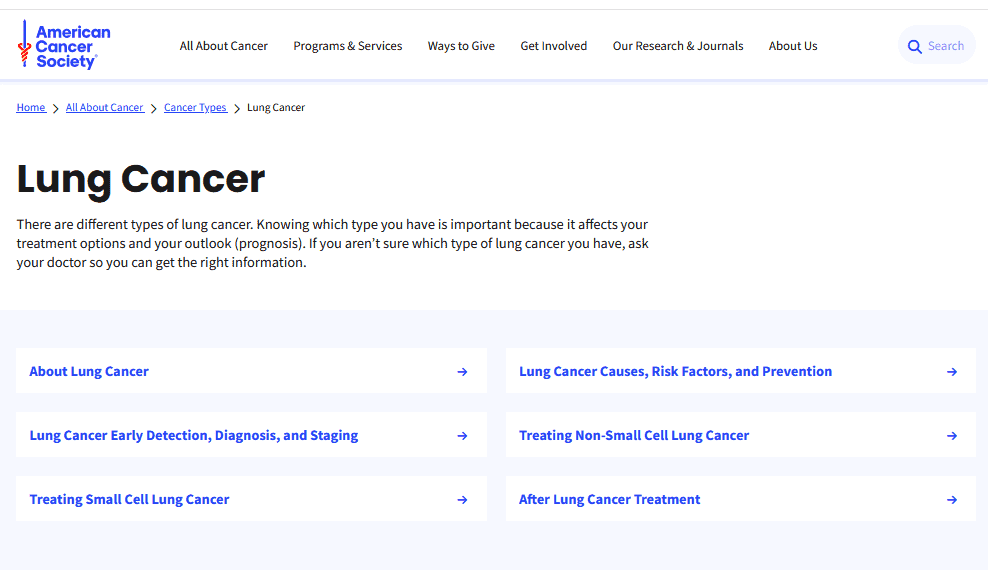
Internal linking checklist
Give every strategic page at least one contextual internal link. Aim for more on big hubs.
Place links inside the main body near relevant copy. Use human‑readable anchors that match intent.
For example, inside a blog post about trial conversions, link “SaaS onboarding emails” to a post about types of SaaS onboarding emails that work well to increase customer lifetime value.
Avoid using the rel=”nofollow” attribute on internal links and make sure related content blocks show genuinely related items, not random posts.
Common mistakes to fix fast
Add these to your checklist so that you can earn more link juice every time you hit the publish button:
- Orphan pages stand in a silo. Add links to them from relevant hubs.
- Duplicated anchors that point to different destinations can confuse crawlers.
- Avoid noindex on key hubs.
- Check your XML sitemap for stray URLs and remove anything that incorrectly redirects or is noindex.
Tools and reports
You don’t need special tools to track internal link juice.
For example, Google Search Console allows you to find internal opportunities. The Links report shows internal link counts so you can spot thin or weak pages.
Then use GA4 in Google Analytics to tie improvements to conversions. If your team uses WordPress, check that the menu logic follows WP coding standards so related modules don’t create loops.
What not to do with link juice
Let’s look at a few lesser-known tactics that you shouldn’t use for link juice, as they can harm your user experience and reputation.
PageRank sculpting
Trying to sculpt with nofollow on internal nav often hurts user experience and discoverability.
Fix the information architecture instead. Keep useful links crawlable and clean. Then add context instead of hiding pathways. If you have pages you want to keep private, just mark them as noindex.
Paid links and disclosure
Paid links without disclosure are risky. If money changes hands, use rel=”sponsored”. It’s always better (and cheaper) to focus on editorial links that you would be proud to show a client. That protects your brand and your rankings.
Plus, ethical and most high-authority sites do not accept links for a fee, unless they’re marked as sponsored or nofollow. Otherwise, this goes against Google’s spam policies and can harm your rankings.
Site reputation abuse and scaled spam
Avoid renting other sites’ authority with low‑oversight content. Google’s recent policy work on site reputation and scaled abuse shows they are watching patterns, not one‑offs.
Keep quality high and your processes human. Nothing beats consistently publishing great, valuable content and then leveraging marketing and relationships to build authentic link juice.
Partnering with top AI SEO agencies makes this a lot easier, especially if they combine link building with scalable content production.
FAQs
Do rel=”nofollow” links pass link juice?
Treat them as hints. Sometimes they help with discovery, but expect little or no link equity.
Are social media links useful?
Yes, for discovery and referral traffic. Do not expect the same equity as editorial links on authority sites.
Indirectly, referral traffic can lead to more followers and buyers, over time increasing your reach. This makes it easier for authority sites to notice your brand and reach out.
Should I use the rel=”nofollow” attribute on internal links?
Almost never. Fix the information architecture instead and keep internal links crawlable.
Does WordPress setup matter for equity?
Yes. Keep URLs tidy and avoid mass 404 redirects to home rules. Follow WP coding standards.
What about link juice keeper or auto‑redirect plugins?
Avoid blanket 404 redirections to the homepage. Use targeted 301s to the best replacement. Update your XML sitemap and internal links.
Conclusion
Link juice still matters, but the winners earn relevant editorial links and route internal link juice with intent. Do the work, watch the data, and protect UX so the value sticks.
Link juice still matters, but today it’s earned through relevance, trust, and clean routing. Earn editorial links that make sense for your audience.
Keep links crawlable, avoid long redirect chains, and use internal links to focus equity on pages that convert. Track what moves the needle in Google Search Console and GA4, then double down.If you want a partner that earns links from authority domains and helps you scale, check out uSERP.
